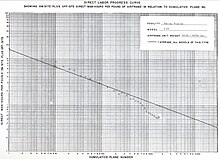
Back Ervaringskromme Afrikaans منحنى التعلم Arabic Öyrənmə əyrisi Azerbaijani Крива на обучението Bulgarian Corba d'aprenentatge Catalan Lernkurve German Καμπύλη μάθησης Greek Curva de aprendizaje Spanish Ikaskuntza-kurba Basque منحنی فراگیری Persian
It has been suggested that this article be merged with Experience curve effects. (Discuss) Proposed since April 2024. |

Graphs are unavailable due to technical issues. There is more info on Phabricator and on MediaWiki.org. |
Graphs are unavailable due to technical issues. There is more info on Phabricator and on MediaWiki.org. |
A learning curve is a graphical representation of the relationship between how proficient people are at a task and the amount of experience they have. Proficiency (measured on the vertical axis) usually increases with increased experience (the horizontal axis), that is to say, the more someone, groups, companies or industries perform a task, the better their performance at the task.[1]
The common expression "a steep learning curve" is a misnomer suggesting that an activity is difficult to learn and that expending much effort does not increase proficiency by much, although a learning curve with a steep start actually represents rapid progress.[2][3] In fact, the gradient of the curve has nothing to do with the overall difficulty of an activity, but expresses the expected rate of change of learning speed over time. An activity that it is easy to learn the basics of, but difficult to gain proficiency in, may be described as having "a steep learning curve".[citation needed]
The learning curve may refer to a specific task or a body of knowledge. Hermann Ebbinghaus first described the learning curve in 1885 in the field of the psychology of learning, although the name did not come into use until 1903.[4][5] In 1936 Theodore Paul Wright described the effect of learning on production costs in the aircraft industry.[6] This form, in which unit cost is plotted against total production, is sometimes called an experience curve.
- ^ Compare: "Learning Curve". Business Dictionary. Archived from the original on 14 August 2020. Retrieved 8 December 2018.
Graphical representation of the common sense principle that more one does something the better one gets at it. Learning curve shows the rate of improvement in performing a task as a function of time, or the rate of change in average cost (in hours or money) as a function of cumulative output.
- ^ Reichenbach, Daniel J.; Tackett, A Darrel; Harris, James; Camacho, Diego; Graviss, Edward A.; Dewan, Brendan; Vavra, Ashley; Stiles, Anquonette; Fisher, William E.; Brunicardi, F Charles; Sweeney, John F. (2006). "Laparoscopic Colon Resection Early in the Learning Curve". Annals of Surgery. 243 (6): 730–737. doi:10.1097/01.sla.0000220039.26524.fa. PMC 1570580. PMID 16772776., see the "Discussions" section, Dr. Smith's remark about the usage of the term "steep learning curve": "First, semantics. A steep learning curve is one where you gain proficiency over a short number of trials. That means the curve is steep. I think semantically we are really talking about a prolonged or long learning curve. I know it is a subtle distinction, but I can't miss the opportunity to make that point."
- ^ Cite error: The named reference
zimmerwas invoked but never defined (see the help page). - ^ Ebbinghaus, Hermann (1913). Memory: A Contribution to Experimental Psychology. Vol. 20. Teachers College, Columbia University. pp. 155–6. doi:10.5214/ans.0972.7531.200408. ISBN 978-0-7222-2928-6. PMC 4117135. PMID 25206041.
{{cite book}}:|journal=ignored (help) - ^ Hall, Granville Stanley; Titchener, Edward Bradford; Dallenbach, Karl M. (1903). The American Journal of Psychology. Vol. 14. University of Illinois Press.
- ^ Wright, T. P. (1936). "Factors Affecting the Cost of Airplanes" (PDF). Journal of the Aeronautical Sciences. 3 (4): 122–128. doi:10.2514/8.155.
© MMXXIII Rich X Search. We shall prevail. All rights reserved. Rich X Search